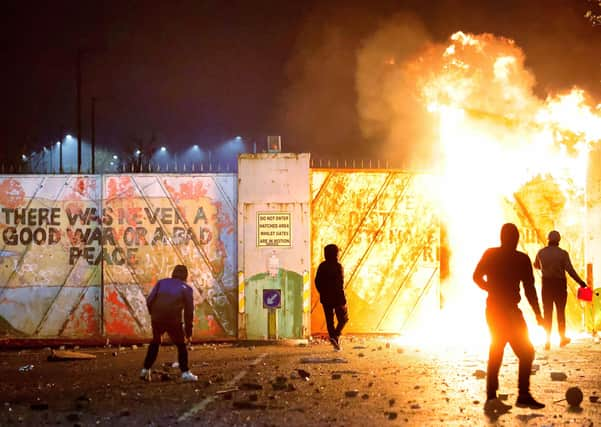‘I dream of a Troubles museum at Belfast peaceline interface’


Curiously this was an outcome that no side, neither republicans nor unionists, had wished for.
Edward Carson, the Dublin-born leader of the Ulster unionists, wanted to keep all of Ireland united within the UK. Eamon de Valera, the President of the breakaway Dáil Éireann of 1919, wanted a united Ireland composed of the whole island.
Advertisement
Hide AdAdvertisement
Hide AdIn the eventual compromise a land boundary came into being, separating the two newly-created states, those of Northern Ireland and the Irish Free State. In a sense, the Border as it came to be known, was simply an expression of the boundaries present in the hearts and minds of people in Ireland, and particularly so in Ulster. Today the most visible expressions of division are the 100 or so ‘peace walls’ to be found in Belfast and elsewhere in the province.
These might be viewed as monuments to political failure. Someday, like the Berlin Wall, they will come down. We have a long way to go, but wouldn’t it be wonderful, as one small beginning, to turn the main Peace Line in Belfast into a resource for the present and the future.
What I am suggesting is a Museum of the Troubles and Peace incorporating part of the existing wall that separates the Lower Falls and Lower Shankill.
A site close to Cupar Way would be equally accessible to both sides of our divided community and could help open up personal contact between the two. The project could also spearhead economic regeneration in two seriously disadvantaged areas. Cafés, boutiques, formal and informal meeting places might be all part of the package.
Advertisement
Hide AdAdvertisement
Hide AdThere is a wider case for a Museum of the Troubles and Peace. A younger generation of our people has no direct experience of the Troubles and not enough contact across the communal divide.
A museum, exhibition centre, peace and reconciliation zone – call it what you will – could help us as a society deal with the past in a way that is challenging but not threatening.
This would require a range of stakeholders, including Belfast City Council, community groups, the British and Irish governments, and the existing museum sector. Particularly important here are the ‘small museums’, especially those with republican and loyalist colourations. One might envisage mutually beneficial cooperation between these and a museum that reaches across all of society and on the scale of the Titanic complex. Setting territorial and related instincts aside for a moment, why not?
If the Troubles have taught us anything it is that the period was hugely complex, all kinds of motives went into the mix, and the many different and often discordant voices need to be heard. This could be economically beneficial, bringing in visitors from home and abroad. More importantly, the project could contribute to community building and reconciliation.
Advertisement
Hide AdAdvertisement
Hide AdSo the vision is of a museum that covers not only the Troubles but also peace and the peace process. One of the untold stories of the past is how families and people managed to live lives against a backdrop of political violence, disruption and sometimes mayhem. This resilience, a people’s history of the Troubles, needs to be acknowledged and celebrated.
In other words, the Troubles was not just about the Troubles.
The ‘high’ politics of the peace has its own drama. The role of John Hume, Gerry Adams, Martin McGuinness, David Trimble, Ian Paisley, Bertie Ahern, Tony Blair, irrespective of whether one agrees with all or any of them in the search for peace, needs to be represented.
There are also the vital roles of the Americans, most notably the mediating work of Bill Clinton, Hilary Clinton and George Mitchell. The European Union played its part as well.
Advertisement
Hide AdAdvertisement
Hide AdSome of these might wish to endorse the idea and open doors to international funding.
The guiding philosophy would be a multi-authored narrative of the Troubles, presented in an attractive form that uses multi-media, digital technology and artefacts from the period to tell the multiple stories of those troubled times, and the aftermath. The story stretches across Ireland, North and South, Britain and Irish America.
The aim for the visitor would be to create an experience that is challenging, educational and memorable. The facility might also include meeting rooms, a youth and audio-visual centre, an oral history centre and a resource unit for community groups.
~ Irene Boada Montagut, project manager, Museum of the Troubles and Peace. Her background is in journalism in Catalonia and Spain, and she has been based in Barcelona and Belfast
Advertisement
Hide AdAdvertisement
Hide Ad——— ———
A message from the Editor:
Advertisement
Hide AdAdvertisement
Hide AdThank you for reading this story on our website. While I have your attention, I also have an important request to make of you.
With the coronavirus lockdown having a major impact on many of our advertisers — and consequently the revenue we receive — we are more reliant than ever on you taking out a digital subscription.
Subscribe to newsletter.co.uk and enjoy unlimited access to the best Northern Ireland and UK news and information online and on our app. With a digital subscription, you can read more than 5 articles, see fewer ads, enjoy faster load times, and get access to exclusive newsletters and content. Visit https://www.newsletter.co.uk/subscriptions now to sign up.
Our journalism costs money and we rely on advertising, print and digital revenues to help to support them. By supporting us, we are able to support you in providing trusted, fact-checked content for this website.
Alistair Bushe
Editor